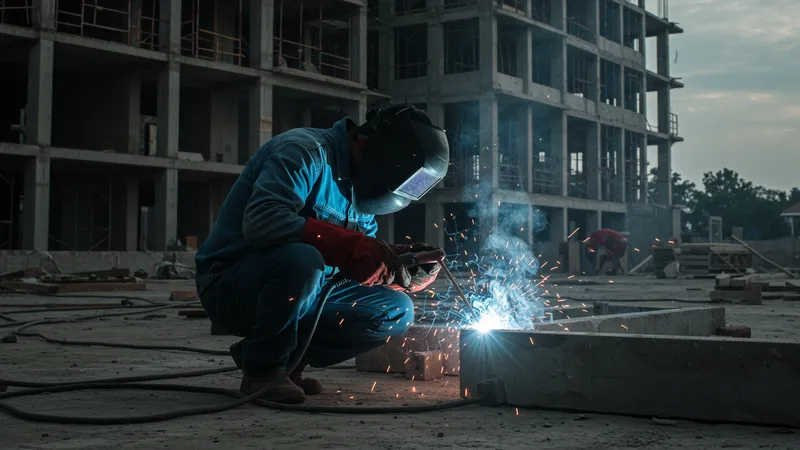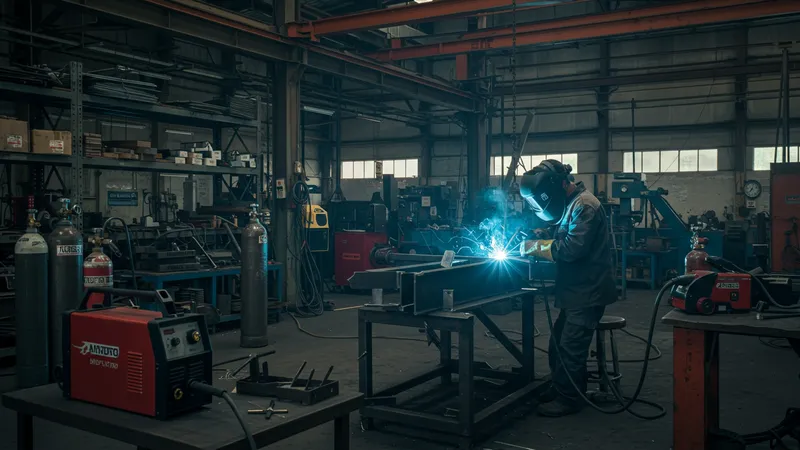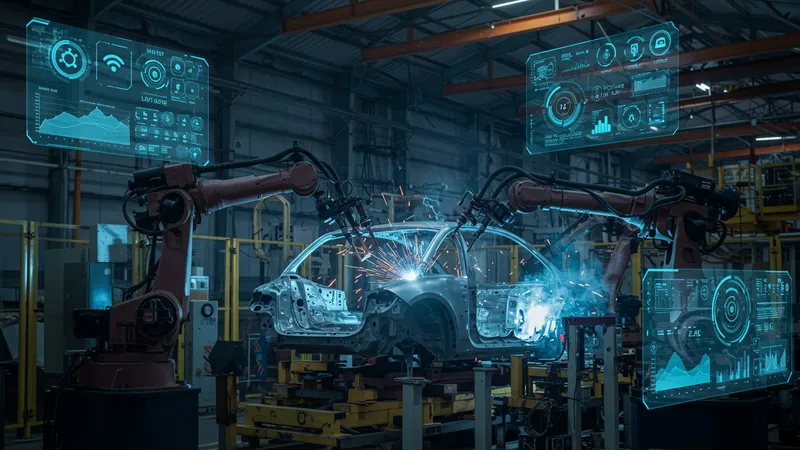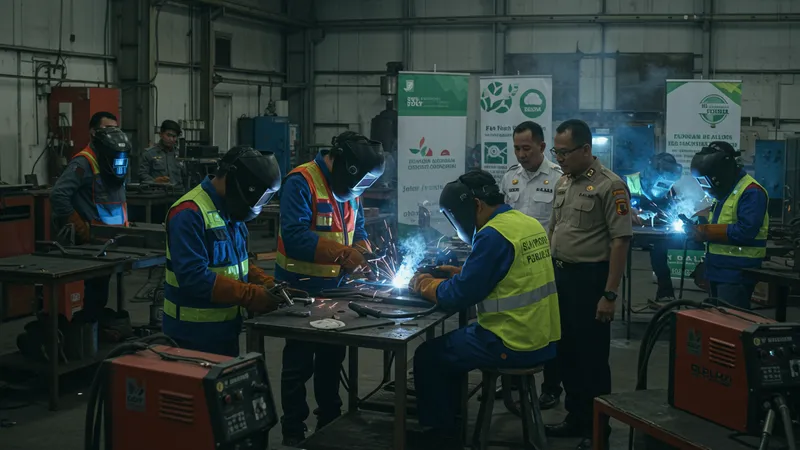

Did you know that countless welders in Indonesia have been making the switch from gas to arc welding over just a few months? Many are claiming it’s revolutionizing the industry. But is that truly the case?
With construction booming like never before, this decision has become crucial for professionals and hobbyists alike. Navigating the complexities of selecting the right method can significantly impact project success.

Shockingly, while gas welding provides superior flexibility, arc welding is lauded for its speed and strength. Many experts argue that the latter often leads to stronger joints, reaping significant cost savings. Yet both methods have unique strengths depending on the application. But that’s not even the wildest part...
The environmental implications of these welding techniques are astounding. ARC welding uses less toxic materials, posing fewer health hazards. Conversely, gas welding’s use of acetylene can lead to harmful emissions. The impact of this difference is influencing Indonesia's push for greener practices. But what’s to come might surprise you even more…
The implications of choosing between gas and arc welding in Indonesia are vast. What happens next shocked even the experts as each method reveals hidden costs and potential benefits that could redefine the industry…
In a demanding market like Indonesia, cost-efficiency is king. Gas welding often seems cheaper upfront, but hidden expenses can inflate overall costs. The price of consumables used in gas welding, such as oxygen and acetylene, adds up rapidly. On the other hand, arc welding requires less expensive consumables, focusing mostly on electricity and inexpensive filler rods. This subtle shift in expenditure has seen Indonesian welders save significantly, with some reporting up to a 30% reduction in operational costs. But there’s one more twist...

For complex tasks involving high-strength materials, arc welding outshines gas welding. However, it’s not just about power and penetration. An insider from Jakarta’s welding industry revealed a hidden truth: the maintenance of gas welding equipment can often surpass the initial savings, tying up resources over time. Meanwhile, arc welding's fewer moving parts translate into diminished maintenance costs. Yet, there’s another angle...
The decision isn’t purely financial. There’s a strategic component. Skilled labor availability impacts costs, as most welders are traditionally trained in gas welding; upskilling for arc techniques incurs additional training costs. Nevertheless, modern facilities now incorporate training in both methods, realizing long-term productivity gains. But the real game-changer comes from the operational efficiencies that follow...
Environmental considerations are also shifting. With global trends pushing toward sustainable practices, arc welding’s reduced carbon footprint aligns with Indonesia's environmental initiatives. This transition is not merely about finances but reflects an overarching trend - combining sustainability with economic efficiency. What you read next might change how you see this forever.
For many applications across Indonesia, strength and penetration are paramount. Arc welding is unparalleled in achieving deep penetration, making it ideal for construction beams and critical infrastructure projects. Its lower heat distortion levels lend a uniform strength across the weld, a critical factor in ensuring structural integrity. In contrast, gas welding's versatility suits it for less demanding, precise work, such as HVAC installations and metal art. However, this flexibility comes with a caveat: its susceptibility to heat distortion can be problematic. But that's not the only concern...

A Jakarta welder once remarked on the consistency of arc welding in adverse conditions. Unlike gas welding, which can be hindered by wind or rain, arc welding maintains performance reliability, crucial in variable weather conditions common throughout Indonesia's construction sites. Yet, gas welding offers strategic advantages in indoor and smaller-scale applications. The ability to adjust between a soft flame for delicate work and a hard flame for more robust welding gives it a unique edge. But there's more to explore...
Another aspect often overlooked is the quality of weld finish achievable with each method. Arc welding’s process results in tighter weld seams, reducing post-welding processing. In comparison, gas welding often needs more finish work to achieve comparable results, impacting project timelines. But then, arc welding also presents challenges in expertise demand, requiring precision and control to prevent heat affected zone expansion. Yet, there's another layer to this discussion...
These stark contrasts reveal that the effectiveness of either welding method is highly situational. With arc welding leading in strength and efficiency, and gas welding championing flexibility, the crux of their rivalry lies in application and expertise. The subsequent pages will delve into yet more nuanced aspects of these methods and their impacts, unveiling deeper intricacies that could sway decisions in unexpected ways.
In recent years, Indonesia has taken significant steps toward reducing industrial pollution, thus bringing the environmental impacts of welding under scrutiny. Arc welding, favoring electric power over combustible gases, tends to have a reduced emission footprint. This positions it favorably against gas welding, which relies on acetylene production that can lead to higher greenhouse gas emissions. The implications for sustainability are profound, as companies re-evaluate practices to align with environmental regulations. But that’s just scratching the surface...

Safety is another critical factor impacting the preference between these two welding methods. Arc welding mitigates the risk of fire hazards linked to gas explosions, creating safer operational conditions. Conversely, gas welding requires meticulous handling of combustible gases, demanding stringent safety protocols. Many workshops have suffered losses from mishandled equipment, underlining the importance of safety-first practices. Yet, industry veterans reveal hidden complexities...
The push for safer working environments has introduced innovative safety measures in arc welding. Modern arc welders feature advanced arc control, reducing spatter and minimizing physical risks. Safety upgrades in gas welding include improved gas regulators and infrastructure, though the susceptibility to leakages remains a concern. International collaboration has helped local industries adopt cutting-edge safety standards, though adherence varies. But there’s another challenge awaiting...
As Indonesia's industries evolve, so too do the approaches toward sustainable and safe welding practices. The future seems veered towards arc welding, yet the ease of implementation and resource accessibility positions gas welding inherently attractive to smaller operations. The debate isn’t just technical - it’s a socio-economic equation with wide-reaching implications still unfolding. What happens ahead could redefine welding practices region-wide.
As the global demand for skilled welders increases, Indonesia faces a dual challenge: the need for upgraded skills alongside evolving industry needs. Training in arc welding requires precise skills, with a focus on understanding the intricacies of electrical systems and electrode manipulation. Upskilling existing gas welders to master arc techniques is resource-intensive, both in time and cost. But that’s where innovation steps in...

Many industrial training centers in Indonesia now incorporate virtual welding simulators, offering an immersive learning experience. This technology significantly reduces material costs and enables learners to hone skills without real-world repercussions. Such innovations are crucial in a landscape where expertise is essential yet resource access can be limited. But that's not the end of the story...
The foundational expertise in gas welding places many workers at a crossroads, determining whether to transition to arc welding or specialize further in their existing skills. Employers are split between investing in training for specialized tasks versus broadening capabilities to incorporate multiple welding techniques. The choice impacts operational agility and project versatility. Yet, the real pivot lies elsewhere...
The power of proper training cannot be overstated. Skilled arc welders command higher wages, reflecting the value of their capabilities in high-demand sectors like shipbuilding and infrastructure. This economic factor drives many towards acquiring arc skills, despite the initial costs. However, strategic industry partnerships geared toward developing comprehensive training modules could soon solve Indonesia's skills gap efficiently. The path forward is lined with possibilities and emerging solutions. Where the journey leads might change industry dynamics completely.
The decision between gas and arc welding does not exist in isolation; it intertwines with supply chain dynamics. In Indonesia, the distribution and availability of welding supplies directly influence choice. Arc welding gear, often locally manufactured, boasts greater availability across major industrial hubs. However, supply chain complexities for gas welding equipment and consumables can disrupt operations, requiring strategic sourcing. But there’s more than meets the eye...

The imports of specific gases and related equipment necessary for gas welding are subject to international trade fluctuations and regulations. These factors sometimes result in bottlenecks, influencing steady production flow. Conversely, the domestic manufacturing of electrical components for arc welding provides a more consistent supply chain. An industry shift toward localized manufacturing holds promise here. But, there's an undercurrent worth examining...
Strategically, businesses looking to future-proof operations might consider the integration with suppliers to ensure a steady stream of materials. Partnerships focusing on shared values, such as sustainability and innovation, are pivotal in creating resilient supply chains. But integrating environmental considerations can upend traditional models. So, what's the next logical step?
In a rapidly industrializing economy, the ability to seamlessly adapt to shifting supply chain dynamics offers a competitive edge. Whether it's innovating through locally sourced materials or re-evaluating supplier partnerships with an eye on reducing dependency on volatile imports, enterprises must navigate this fluid landscape smartly. As the industry moves forward, transparency, collaboration, and strategic foresight will be key players in shaping the trajectory of welding practices in Indonesia.
Technology paves the path toward the future of welding in Indonesia. Automated arc welding systems are revolutionizing production lines, increasing efficiency beyond human capability. Industrial robots equipped with arc technology offer consistent quality and unrivaled speed, marking a significant leap for sectors like automotive manufacturing. But that’s only scratching the surface of technological transformations...

Remote sensing and IoT integrations present a new world of possibilities, especially in predictive maintenance. Monitoring system health and performance in real-time minimizes downtimes and extends equipment lifespan. These technological advancements foster a proactive rather than reactive maintenance culture, reshaping operational norms. Yet, questions about implementation expenses arise...
Deployment costs of advanced technology can seem daunting. However, significant returns on investment in the form of production efficiency and personnel safety are noteworthy. Companies face the pivotal choice between adopting cutting-edge technology now versus playing catch-up. Yet, what if beyond the cost, the real question is readiness in workforce adaptation?
The digital divide presents challenges where bridging the gap between technology access and workforce readiness becomes imperative. Training unskilled labor to operate advanced systems is as crucial as acquiring the infrastructure itself. As methods get smarter, Indonesia must scrutinize technology's role not just as a tool, but as a collaborative process where humans and machines work symbiotically. The fusion of these spheres hints at unprecedented horizons to be explored next.
Welding in Indonesia is at a crossroads, where current global and local trends shape its course forward. There's an inevitable shift towards sustainable practices with a noticeable tilt toward environmentally-friendly materials and techniques. Eco-conscious consumers and regulations drive this change, presenting welding as a contributor to broader ecological goals. Yet, this is more than just an environmental shift...

Amidst these changes, gas welding’s flexibility holds sway in artisanal crafts and fine metalwork—areas less influenced by industry-wide trends but highly respected in cultural heritage circles. Hence, a balance between tradition and modern requirements shapes market trends. But the real transformation isn't solely about practices; it's about outcomes and expectations...
This trend toward faster, more efficient workflows demands adaptive production strategies. The ability to swiftly switch between gas and arc welding methodologies depending on project specifics reflects evolutionary adaptability—a necessity rather than an option. However, a further twist lies not just in adapting, but in mastering the harmonization of methods. So, what's the secret ingredient?
The symbiosis of both welding formats might hold the future, crafting a hybrid approach where strengths complement weaknesses. Forward-thinking approaches already see industries leveraging dual-method capacities, optimizing processes with custom interventions. Such innovation portends a reshaping of business models, heavily focused on versatility and adaptability, both vital for riding the waves of emerging industry shifts and staying impeccably competitive. As the understanding deepens, so do the possibilities for welding in Indonesia.
Examining welding practices globally, Indonesia finds itself amid a dynamic landscape of competition and innovation. In contrast to Western counterparts, whose reliance on advanced arc systems is pronounced, Indonesia balances traditional gas methods with burgeoning arc innovations, offering unique dual-strength. Yet, it’s not merely about the current snapshot—there’s a wider narrative unfolding...

A prevalent trend sees regions enhancing infrastructure development, where Indonesia’s robust pipeline project push parallels global counterparts' endeavors. Capitalizing on well-conceived strategies that entwine modern techniques with tried-and-true practices influences its standing in the global arena. But the pivot hinges on economic ramifications much deeper in scope...
While transitioning toward more technologically advanced methodologies, cost efficiency remains paramount. Comparatively lower labor costs in Indonesia accentuate its appeal for global contracting work, showcasing capabilities in competitive markets. Yet, cost alone isn’t the game-changer; it’s the nuanced embrace of both cost and innovation. Still, there’s a missing piece to this equation...
With a rich seam of untapped potential in uniting traditional craftsmanship with cutting-edge technology, Indonesia holds a significant position in the welding world stage. As global comparisons unfold, aiming beyond current capabilities toward innovative synthesis may redefine Indonesia's role, not merely as a participant, but as a leader in tomorrow’s welding innovations. As we peer into future possibilities, a compelling destiny awaits.
Cultural contexts strongly influence welding preferences in Indonesia, diverging in both methodology and application. Traditions tied to craftsmanship see gas welding employed in local art forms and intricate metalwork, where precision and finesse are revered. But gas welding's cultural importance goes beyond art...

Social constructs and local education systems heavily prioritize certain skills over others. As artisans inherit generational expertise in gas welding, this venerable skill remains in demand. However, new waves of educational reform aim to incorporate modern arc welding techniques into the curriculum, adapting cultural pride with evolving innovation. Yet, this evolution is far from straightforward...
Navigating cultural and technological rifts requires sensitive, balanced approaches that embrace cultural heritage while fostering technical advancements, cultivating a bridge across generational divides. Arc welding’s introduction into educational pathways secures a place for upcoming talents in global markets, though thoroughly integrating this modern technique harmoniously into cultural frameworks demands insight and tact. But there's a deeper, underlying movement here...
As Indonesia’s culture itself evolves, a broader spectrum emerges—a diversity in method selection reflecting amplified capabilities through inclusion. Where cultural values and technological progress interact lays the path to enriched, diversified outcomes in welding practices, echoing both ancestral and contemporary narratives. This intricate balance, once mastered, might just be the potent driver redefining welding’s future in socio-culturally integrated ways, resonating throughout the region and beyond.
The economic implications of welding practices in Indonesia reveal more than mere numbers; they chart a course for industry sustainability and growth. Welding serves as a vital component in economic initiatives, shaping critical infrastructure projects—from efficient transportation networks to sprawling commercial developments, underpinning future progress. Yet, economics in welding is a multifaceted story...

Skills gaps remain an economic hurdle with arc welding. The supply of skilled laborers shapes project timelines and quality, impacting bottom lines. Government and private entities increasingly collaborate in establishing training pathways blending both gas and arc welding skills, enhancing worker versatility while aligning with economic strategies. Yet it’s more than a workforce issue...
Value addition extends beyond the immediate workforce. Innovations in welding bolster competitive standing for locally produced goods poised for export, driving economic empowerment. Gasoline's role as a historic energy source within Indonesia juxtaposes with the global push for greener solutions, transforming operational ethos for broader economic benefit. However, a pivot occurs not just in product production but in strategic foresight toward economic resilience...
The emphasis on nurturing an environment where resource efficiency and technological advancement thrive embodies not only an economic agenda but a vision. Welding then becomes a microcosm encapsulating wider economic renewal efforts, offering tangible outcomes in Indonesia's journey toward substantial, sustainable growth. The ultimate trajectory ties seamlessly into national ambitions, forecasting promising vistas ahead. The ensuing quest in reconciling economic aims with strategic imperatives will undoubtedly craft a legacy in Indonesian industry practices to come.
The Indonesian government’s stance profoundly influences welding’s regulatory framework, driving innovation and enforcing safety within the industry. Policies incentivizing eco-friendly practices encourage arc welding’s emergence due to its lesser environmental impact, whose compliance aligns with national green initiatives. But governmental reach goes further...

Strategic regulatory frameworks ensure workplace safety remains paramount. Welding operations, often laden with safety risks, now see mandated protocols for periodical inspection and equipment servicing, especially concerning gas welding's reliance on volatile substances. Local industries now collaborate extensively with governmental bodies, spearheading workshops that balance practical execution with regulation adherence. However, comprehensive reform isn’t the sole challenge.
Clearing hurdles related to regulatory compliance necessitates smoother integrative interfaces for manufacturers and operators, promoting widespread adherence. Government initiatives not only define immediate frameworks but also set long-term agendas that challenge traditional perceptions of compliance as barriers, proposing them instead as enablers for innovation. As these deeper interactions materialize...
Policy and regulation intertwine with industry practice, not as dichotomies but as symbiotic opportunities envisioning Indonesia’s trajectory toward safer, more efficient industry workings. The fusion of governmental foresight with grounded industry acumen promises to reforge Indonesia's standing in the global welding arena. As rules evolve alongside technology, so too should the perceptions and applications cementing this dynamic synergy for future enhancement.
Real-world insights from Indonesian welders offer vibrant testimonies to gas and arc welding’s dimensional spectrum. One artisan’s recounting depicts gas welding’s finesse in crafting intricate Bali-inspired sculptures—an embodiment of artistry precision. Here, the story underscores community and culture’s haute fusion with technical skill, painting diverse narratives. And yet, there is more...

In urban construction, an arc welder’s experience narrates a contrasting tale of technological integration. The accelerated efficacy in erecting Jakarta’s skyscrapers highlights a breadth of applicability reserved for arc welding’s strengths, representing progress embedded within Indonesia’s skyline. Beyond mere construction, these stories reflect transformational technology adoption but also reveal overlooked challenges...
Each welder’s narrative weighs method selection as a tangible execution path linking intricate craftsmanship to rapid development, the choice echoing contextual nuances beyond black-and-white distinctions. Integrative learning from these diverse applications enriches firsthand understanding while illuminating adaptability’s instrumental value across varying sectors. Yet, not every lesson unfolds as expected...
Unpredictable market shifts sometimes recalibrate practice perceptions, adapting traditional methods to abreast novel challenges or exploring hybrid methodologies bridging distinct techniques into unified operations. These field-gathered insights articulate the broader canvas—encompassing individual creativity, emergent technology prowess, and contextual adaptability. They intricately thread singular experiences into collective tapestries profoundly reshaping Indonesia’s welding narratives and onward journey.
Indonesia's welding industry stands on the brink of transformative opportunities. Anticipated infrastructural projects will leverage cutting-edge welding technologies blending efficiency with ecological priorities. As industries strategize emergent methodologies, sustainability emerges as an inexorable pursuit shaping resource deployment. Yet, within this sustainability narrative hides a lesser-discussed aspect...

Localization efforts seek to stimulate community employment and skill enhancement, driving community-centric industrial footholds. Innovation centers and local workshops foster skill acquisition harmoniously aligned with technological transference. Integration within educational frameworks foreshadows industrial evolution, cultivating a workforce adept in adapting skills across progressive frontiers. This trend highlights regional growth propelled by human capital redevelopment. Meanwhile, looming on the horizon is an aspect integrating these growth trajectories...
Sustainable practices drive concurrent innovations ensuring reduced environmental impact from operations. Welding techniques incorporating renewable energy showcases, recycling programs, and efficient waste management cultivate a holistic mesh marrying accountability with ingenuity. Challenges await integrating such sustainable frameworks amidst evolving industry standards. Yet, an undercurrent ripe with potential awaits cultivation...
The synergy between technological progression and socio-economic initiatives emerges as pivotal, reimagining not just metalwork potential but broader industrial efficiencies. Collaborative platforms bridging governmental support with industrial acumen and educational outreach promise to navigate and harness these nascent opportunities into forceful, pioneering pathways. As the future unfolds, the prospect lies in unison, crafting Indonesian welding into a beacon of innovation and adaptation against growing global standards.
The welding choices confronting Indonesian industries transcend mere technical predilections. The decision to favor gas or arc welding encompasses economic implications, environmental commitment, cultural influences, and technological readiness—factors orchestrating an intricate dynamic defining Indonesia’s industrial prospects. Navigating such complex terrain demands foresight and agility, capitalizing on opportunities that welding’s embrace catalyzes across diversified sectors whilst embedding necessary sustainability ethos.
These concentrated efforts echo potential narratives transcending present challenges, situating Indonesia rich with opportunities for industry leadership and expansion. As next-generation welding practices take root within this promising context, the path forward invites shared exploration and collaboration anticipating exciting new developments in the metalwork domain. Share this journey and remain attuned to welding’s evolving landscape poised to reshape Indonesian industries and beyond.